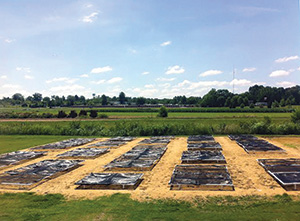Bermudagrass: light integrals for green establishment
By Benton Hodges, Ph.D.

Shade tents on the research green at the Foil Plant Science Research Center in Starkville, Miss. Photo: Benton Hodges
In the transition zone, many superintendents are considering a putting green cultivar conversion. Whether the conversion is from creeping bentgrass to bermudagrass, upgrading from an older bermudagrass cultivar, or early adopters of the ultradwarf bermudagrasses, they are looking to renovate. A major constraint will be the successful establishment under reduced light environments due to the poor shade tolerance of bermudagrass. Currently, no research studies exist determining the light requirement for bermudagrass putting green establishment. Therefore, the objective of this research is to quantify a daily light integral requirement for successful bermudagrass putting green establishment.
A daily light integral is the amount of photosynthetic light a plant receives each day, measured in moles of light per day (mol/d). A field trial was initiated in June 2013 in Starkville, Miss. Four bermudagrass cultivars (Champion, TifEagle, MiniVerde and MS-285) were established under full-sunlight, 30 percent, 55 percent and 80 percent shade using a neutral density, polyfiber black shade cloth. Using data loggers and quantum light meters, daily light integrals were calculated for each shade level. Full-sunlight plots received 40.7 mol/d, while 30 percent, 55 percent and 80 percent shade received 31.3, 19.7 and 10.2 mol/d, respectively.
At the conclusion of the study, using statistical regression analysis, the amount of daily light required to reach 70 percent cover was determined. MiniVerde required the least amount of light with 26.9 mol/d, followed by Champion with 29.9 mol/d. Meanwhile, TifEagle and MS-285 required 30.1 and 31.3 mol/d, respectively. When comparing full-sunlight and 30 percent shade to 55 percent shade, a 25 percent reduction in chlorophyll, a 45 percent reduction in clipping yield, a 28 percent reduction in color, and a 90 percent reduction in percent cover was noted.
The results noted above only represent 2013. This research will be repeated in summer 2014.
Benton Hodges, Christian Baldwin, Ph.D., Barry Stewart, Ph.D., Maria Tomaso-Peterson, Ph.D., and Gene Blythe, Ph.D., Mississippi State University. Benton Hodges can be contacted at bphodges@gmail.com for more information.








